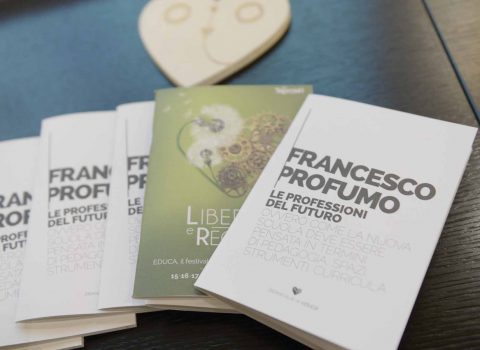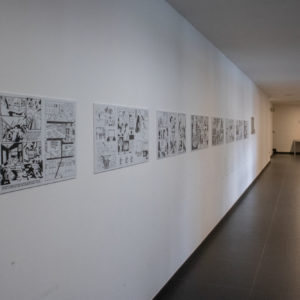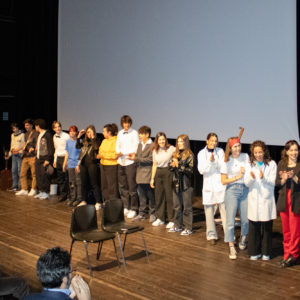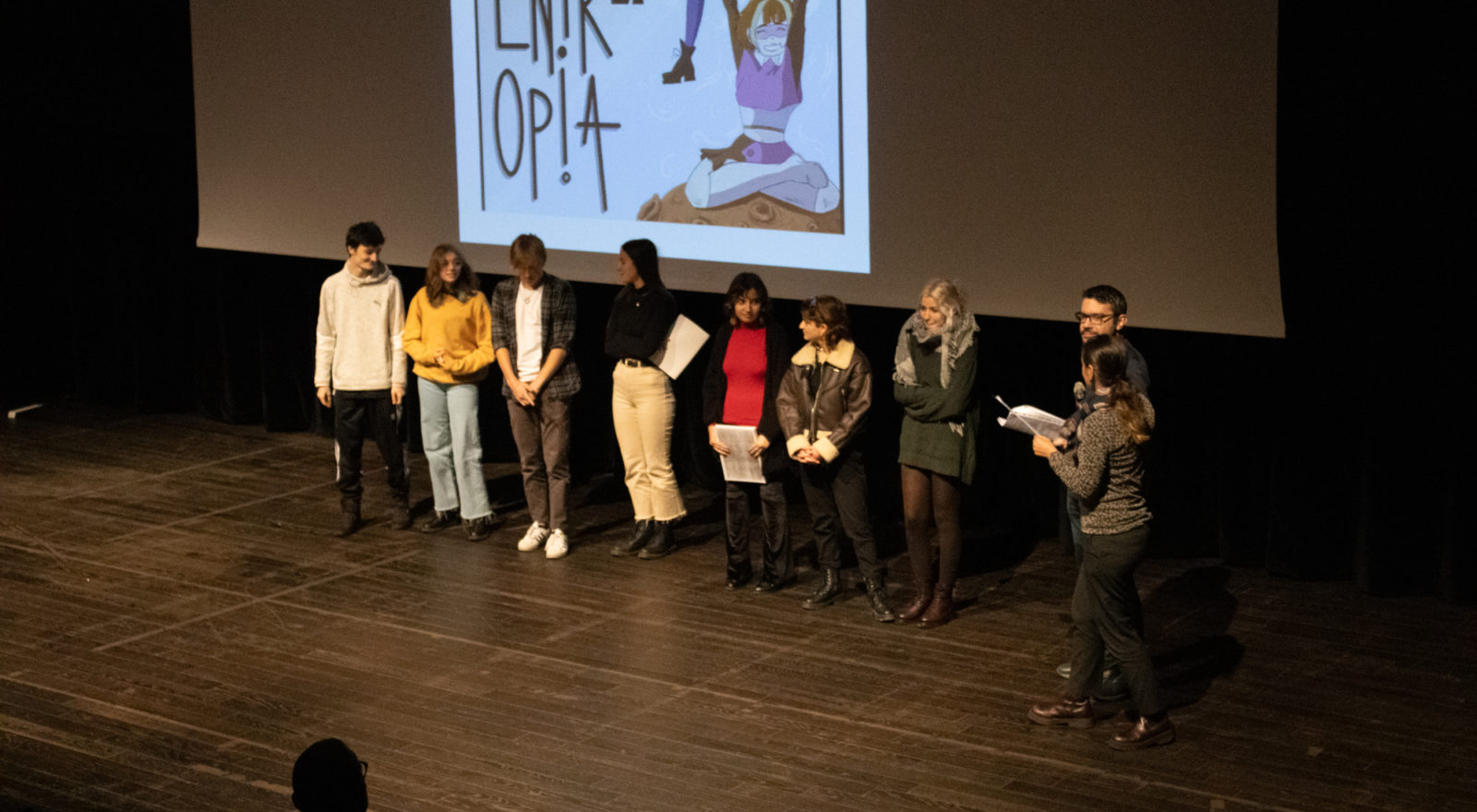
A great premiere for cheEntropia!
A final multimedia event for the conclusion of the project that involved five local high schools.
A very ambitious project, and right from the name: cheEntropia! Started a year ago and financed by the CARITRO Foundation (Bando Reti Scuola Territorio per la co-progettazione tra realtà scolastiche e realtà del contesto territoriale 2021), the project saw its conclusion on a frosty Monday morning in late November (the 28th, to be precise) at the SanbàPolis Theater in Trento. However, once inside, the cold was soon forgotten and one was instantly infected by the warm enthusiasm of the young students who crowded both the stalls and the stage. Yes, because the real stars of this concluding event were the classes from ITT Buonarroti (lead school), Liceo scientifico Galilei, Liceo scientifico Maffei, ITT Arcivescovile, and Liceo Artistico Vittoria – with the collaboration of Istituto Artigianelli – that worked side by side with professors and experts to produce a two-act play, a short film and a graphic novel. The common thread, as the name of the project suggests, was entropy, an almost commonly used word that everyone sooner or later happens to use, but perhaps not quite correctly. Entropy has to do with the concept of disorder, of chaos that increases more and more until it becomes unmanageable, intolerable, out of our control, and the kids started precisely from a rigorous description of this concept, its meaning and its calculation. They confided in us that they had studied the topic for a long time, helped by their respective teachers, and once they were sure they had understood it, they tried their hand at a challenging reworking of it from an artistic and multimedia perspective, as the means to communicate the concept to the lay person.

The theatrical performance consisted of two independent acts, the first by the fifth year students from the Liceo scientifico Maffei and the second by the fifth year students from the ITT Buonarroti, produced with the valuable guidance and supervision of Andrea Brunello and Paolo Vicentini (Compagnia Arditodesìo | Jet Propulsion Theatre).
The actors of the first act releaved to us after their performance that making science compelling was hard, but it helped unite the class to reach the final goal, i.e. the staging in a real theater. With the concept of entropy clearly in mind, they first chose a topic to tie it to (microplastic pollution), then drafted a script that could correlate uncontrolled natural processes-the failure to properly dispose of plastic waste-to the health of us all. They did not fail to point out, with moving pride, that the play was written by one of their classmates, and the musical accompaniment was created also by two boys from the same class.
The second act succeeded in brilliantly illustrating how the disorder produced by a series of out-of-control spontaneous actions can lead to worrisome situations in the future, with high entropy content, which cannot be totally recovered, thus leading to an inevitable, further increase in entropy. The stage effect was ensured by objects being thrown left and right by the actors from the stage.

Both acts included references to the scientific explanation of entropy and the timeline that emphasizes the continuous unstoppable growth of the entropic content of the environment in which we live. In the first act this concept is underscored by the manifestation of a pathology in a young protagonist, in the second by setting the story inside a train from which it was not possible to get off, a train that proceeded inexorably toward a one-way journey, just like time.
“We know that time always flows forward, from the past toward the future”-scientific communicator Matteo Serra, who was called to moderate the final meeting, commented on the subject- “The existence of this ‘arrow of time’ can be explained precisely because of the concept of entropy. We have all observed a vase braking into a thousand pieces, but no one has ever observed the “rewind,” i.e., the opposite process (a thousand pieces spontaneously coming together to form the vase again): this is because in the first case there is an increase in entropy, which is the state toward which all physical systems spontaneously tend. In contrast, the reverse process would lead to a decrease in entropy, but this can never occur spontaneously. That’s why the arrow of time always points forward!”
After theater, it was the turn of cinema, with a real short film made by Arcivescovile and Galilei High School: in 20 minutes, the students told in cinematic language a “story of ordinary entropy,” in which a Galilei student, initially skeptical about the use of knowing the meaning of such a concept, discovers why it is instead so important and recurring in everyday life. As her mentors, she hes three candid ghosts loosely inspired by Charles Dickens’ A Christmas Carol, who pass the baton from explaining the concept of entropy to its inevitable connection with our daily actions and, finally, its projection into the future. The activity was supervised by physics professor Raffaello Potestio from the University of Trento.
This activity, too, helped create bonds of collaboration and friendship between the students of the two institutions, who over the course of this past scorching summer gathered in out-of-school spaces to film, assemble and edit the scenes. One of the students in charge of the technical work revealed that it was during a school-to-work internship that he learned how to make this kind of product.
And finally, the graphic novel – whose title was deliberately separated into wrong syllables (ENTR-OPIA) as an indirect reference precisely to the chaos of entropy – welcomed visitors unrolled on a series of panels at the entrance. IIT Buonarroti was initially responsible for developing the plot, which some students from the Vittoria Arts High School embedded inside black-and-white graphic strips, under the skillful guidance of their teachers (some of whom are professional cartoonists). Exceptional supervision was provided by Agnese Sonato from the Accatagliato Association, an expert in science communication for young people.
Although it was a scientific topic, the concept of entropy was addressed, as requested by FBK, with an equally relevant contribution from the humanities, which provided the narrative flow, thus fostering teamwork also among the tutor teachers of the participating classes.
Finally, another contribution materialized during the wrapping-up event: thanks to the work carried out by some students of the fifth year from Istituto Arcivescovile, the morning performances were documented with a real photo shoot.
The project, coordinated by FBK’s Research and Innovation for Schools Unit, was supervised by Raffaello Potestio, associate professor at the Department of Physics at the University of Trento, who together with FBK researcher Pierluigi Bellutti provided his scientific and rigorous point of view on the reliability of the three produvts produced. So, a great premiere for cheEntropia!, whose success was perfectly described by ITT Buonarroti teacher Assunta Iannone with these words: the participants, with their commitment and collaboration, were able to address and convey the complexity of a scientific concept, each making their own, unique contribution. Just as education aims to do every day, cheEntropia! has been able to celebrate the complexity and diversity inside each student.

